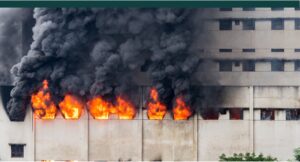In the event of a catastrophic commercial property loss, the process of getting your business back up and running can be overwhelming. Although infrequent, these types of claims can severely impact operations, earnings, team members and the company’s reputation. Responding to a loss can seem daunting in the moment, especially considering the first few hours following a loss are some of the most critical. For these reasons, it is important to have a plan in place prior to a loss occurring.
This guide is designed to help you navigate the commercial property claim process, including filing a claim and receiving payment, so that you can get back on your feet as quickly as possible. You will find recommendations on what actions to take before, during and after a loss; information on commercial property coverage; and examples of common pitfalls insureds frequently make that can cause claim delays.

Before the Loss
The claims process can be time-consuming and burdensome, often leaving insureds unsure of where they stand with their claims. However, preparation can help minimize much of this frustration. In fact, many property claim issues can be avoided or mitigated by thoughtful planning before any loss takes place.
To better prepare your property and team for a loss, consider taking the following actions before any damage occurs:
- Understand your coverage. Read and review your policy carefully, particularly the insuring clauses and exclusions. This can help you understand your rights and obligations before damage occurs, as well as what types of damage are and are not covered under your policy. Any coverage issues discovered should be addressed before the loss.
- Identify key points of internal and external contacts. Prepare your team for a loss by identifying key individuals to act as points of contact. This may include players in sales, operations, accounting and finance, warehousing, management and risk management interacting efficiently and effectively with claims specialists regarding salvage, repairs and resuming operations.
- Secure important documents. Ensure financial records, inventory records, appraisals, building drawings and other important documents are properly secured in a fireproof or off-site location. Data should also be continuously backed up to a remote server or the cloud.
- Create equipment inventory and take photographs. Document equipment inventory and take photographs of the property to prove the extent of future potential damage. New photos of the property should be taken each year or after any alterations have been made.
- Establish a disaster plan and anticipate your loss. Create and communicate your disaster plan with employees to ensure everyone is prepared for disaster. By anticipating your loss, you may be able to mitigate some damage and alleviate concerns before damage occurs. Execution of the disaster plan may include cutting master keys to all areas of the property, moving furniture or potentially hazardous items inside, and having an up-to-date emergency contact list.
During the Loss
A commercial property loss can happen at any time for various reasons, including fire, water, wind or vandalism. Once you’re made aware of a loss, it’s important to take immediate action to mitigate the damage and prevent further damage from occurring.
The following are steps to take in the event of a loss:
- File the claim. File your insurance claim to your property insurer and notify your broker or agent as soon as possible. The carrier will then assign an adjuster to the claim. The adjuster will review the damage.
- Prevent further damage. Implement immediate emergency measures to help protect the property from more damage. Insurance policies require action to be taken to protect and preserve the property following a loss.
- Document and photograph damage. Make sure to take wide-angle and close-up shots of all damaged property, adding verbal or written notes when necessary. If security camera footage exists, keep it in a safe spot and back it up, if possible. In addition, don’t discard anything before the adjuster inspects all property and photographs it.
- Restore fire protection. Replace damaged sprinkler heads, arrange fire watches, and recharge extinguishers to get your fire protection system back in service immediately.
- Begin salvage. Inspect all potentially damaged property and separate it from undamaged property. Start developing a full inventory, describing each item and recording the manufacturer, the original purchase price, and estimated costs to replace, repair or clean.
- Make temporary repairs. Save, preserve and protect your property by making temporary repairs. When assessing if temporary repairs are necessary, use the “reasonable person” test—do what a reasonable person would do and be able to explain your rationale to the adjuster. Inform your adjuster of the temporary repairs as soon as possible; actions taken without prior authorization could potentially impact recovery for those expenses.
- Make permanent repairs. Begin making permanent repairs after consulting with your adjuster, who will likely engage with a construction consultant to help develop a scope of work and then invite two or three contractors to bid on the scope of work. After the itemized bids are presented, you, your adjuster and the construction contractor should all agree on a price for the reconstruction work.
- Track claim costs. Create a ledger to track all costs associated with the loss. You can use work orders, job accounts and other accounting procedures to track every cost. Categories within the ledger may include temporary repairs, building reconstruction and contents replacement costs.
- Resume operations. Take the necessary steps to resume normal operations as quickly as possible. This could include setting up a temporary location, working extra shifts to restore production or purchasing product from a competitor to continue supplying customers.

Components of Commercial Property Coverage
One of the most essential steps to getting your business up and running following a commercial property loss is having the right coverage in the first place. The proper coverage can make all the difference between a minor disruption to operations and a severe financial loss.
A commercial property insurance policy is typically divided into several sections, and different types of records are required when documenting each element. Here are the basic components of commercial property policies:
- Commercial building coverage—Following a loss, property damage may be partial, or the building may be completely destroyed. In the event of a partial loss, the claim will mostly consist of repair costs, including labor and materials. If the building is destroyed, a formal appraisal can help determine the value for claim purposes.
- Business personal property—Business personal property coverage may include equipment, fixtures, materials or supplies. Equipment and fixtures in need of repair typically only require an invoice to present your claim. However, those in need of replacement may require estimated replacement costs from manufacturers or dealers if they are still relatively new pieces. The replacement of older equipment and fixtures may require your capital assets ledger, acquisition costs, appraisals and maintenance logs before actual cash value can be determined. Materials and supplies figures can be relatively simple to develop based on the last physical inventory plus purchases less sales. The valuation method of your damaged and undamaged property may depend on your policy provisions, and there may be possible issues in treating freight, purchasing and selling expenses, bad debts, shrinkage, returns and allowance, commissions and discounts.
- Business interruption—Most business interruption policies only take effect when there is a definitive loss of sales due to stopped operations, physical loss or damage to covered property by a covered peril. If you can reduce business interruption by resuming complete or partial operations, utilizing or renting other facilities, or using raw stock, stock in process or finished stock, you may be entitled to recover the extra incurred expenses.
- Extra expense—Extra expense coverage and expense to reduce loss coverage are considered two separate categories. Expense to reduce loss typically falls under business interruption coverage and requires that every dollar spent reduces the business interruption claim by a dollar. Extra expense, however, must be purchased as a separate coverage under most policies and allows you to spend more than the dollar saved to continue normal business operations.
It may seem overwhelming to deal with a commercial property loss, but fortunately, you don’t have to do it alone. To learn more about commercial property coverage and specific policies available to you, it’s important to work with a qualified insurance broker. Contact us today to learn more.









